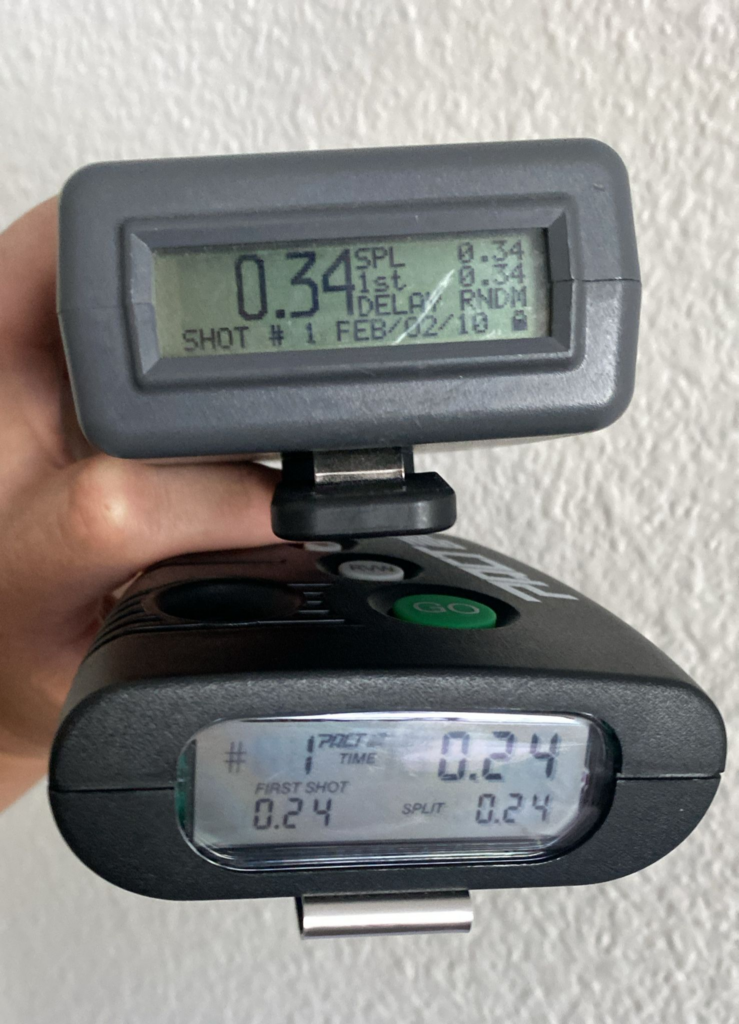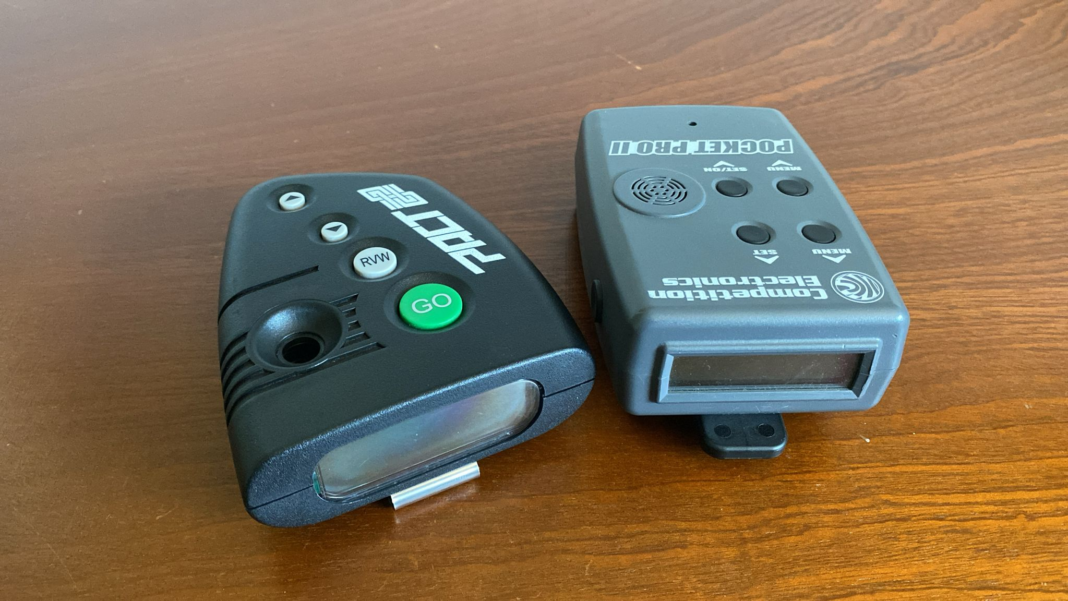As far as training with firearms is concerned, shot timers are essential tools in the repertoire of both the serious student and trainer. Much like the whistle hanging around the neck of any field sports coach, the shot timer might as well be the whistle in the world of firearms. These days, shot timers are evolving with the latest technology and can connect via blue-tooth and talk to apps on cell phones or tablets for score keeping and time management. Hell, today, the latest and greatest devices can even recharge exactly like a modern phone.
However, we mustn’t forget about the two classic workhorses in this arena: the Competition Electronics Pocket Pro 2 and the PACT Club Timer III. Both of these shot timers are fast approaching the threshold of becoming old school, but in reality, they’re still perfectly viable and useful. I use both on a regular basis, and I like them for different reasons.
Competition Electronics Pocket Pro 2 Shot Timer
Though now discontinued, the Pocket Pro 2 is one of the most popular “classic” shot timers. Even today, it’s not hard to find them in the range bags of many shooters. The Pocket Pro 2 was the updated model that succeeded Competition Electronic’s original Pocket Pro (which ironically can still be purchased brand new).
Pocket Pro 2s remind me of my childhood when many toys and games ran off 9-volt alkaline batteries. These devices still have that quartz display screen and late 1990s chunky aesthetic of the era. There’s a spring-loaded belt clip on the back of the device so that one can hang the Pocket Pro 2 off their belt or pocket while training alone.
Using the Pocket Pro 2
Navigating through the settings and controls is also reminiscent of sending text messages on pre-smartphone devices. Likewise, there’s a bit of a learning curve to get the hang of it. But it’s not too bad once the user understands its rhythm. The black/green display itself is also reminiscent of the Texas Instruments Ti-34 calculator I used to bring to school.
Settings for timer start delays and par times are easily adjustable along with the device’s shot sensitivity, loudness, and brightness. I figured out early on that it’s best to run the display as dark as possible to conserve battery life. And honestly, when shooting outside during normal daylight hours, it has never been an issue.
The ability to adjust the loudness of the beep is much appreciated, especially when working and dry-firing inside the house, where normal shot timer beeps can be deafeningly loud (especially without hearing protection).
Durability-wise, my Pocket Pro 2 has generally held up okay, and I’ve never been exceedingly rough on mine. But at some point, I did have a failure in which the soldering between the battery terminal pad and the wire that powered the electronics gave out. A good friend of mine was nice enough to re-solder the connection and bolster it. I haven’t had any issues with it since he repaired it.
The Pocket Pro 2 has now been succeeded by the Competition Electronics Pro Timer and the Pro Timer BT (Bluetooth). Mine works fine, and I have no plans to retire it anytime soon.
PACT Club Timer III
The PACT Club Timer III is probably the most direct competitor to the Pocket Pro 2. And this shot timer works almost the same as its rival, save for some subtle differences. For example, the Club Timer III also uses the basic low-tech “calculator screen” display and runs off a 9-volt battery. Its external shell is also fairly voluminous, and it has a clunky body, although it’s more rotund and “aerodynamic.”
This device also comes with a handy spring-loaded clip, which makes it easier to hang off a belt or pocket for self-directed training sessions. Anyone who can successfully navigate the Pocket Pro 2 timer should also be able to navigate the Club Timer III settings just as easily.
Pocket Pro 2 vs Club Timer III: The Differences

In many ways, comparing these shot timers is no different than making a classic Coke-vs-Pepsi comparison because both are so similar in form and function. But there are some differences that should be taken into account. The most obvious one is that the settings on the Pocket Pro 2 are far more user-adjustable than the settings on the Club Timer III.
For example, users can adjust the “beep’s” sound level on the Pocket Pro 2 from very soft to quite loud, while the “beep” on the Club Timer III is immutable—and loud. Without hearing protection, the Club Timer III’s beep can be as loud as a smoke alarm and honestly unpleasant to work with indoors.
Similarly, the Club Timer III’s “delayed start” time is fixed at 3 seconds, while the user can adjust it to whatever time they want with the Pocket Pro 2. I work with the Club Timer III on a regular basis, and the fixed three-second delay time has never been a hindrance.
Build
Externally, the Pocket Pro 2 resembles a 1990s boxy Mercedez (or a giant pager), while the curvier Club Timer III resembles a Volkswagen Beetle. Both have the same footprint, but the Pocket Pro 2 isn’t as wide.
The Club Timer III edges out the Pocket Pro 2 with its bigger display. Not only is it physically larger, but it’s also easier to see pertinent information like “DTFS” (draw to first shot), number of shots fired, and splits than it is with the Pocket Pro 2.
Sure, the latter will also show this information on its main screen. But I think the Club Timer III’s presentation is simply cleaner.
Price
The honest truth is that, currently, the PACT Club Timer III is probably the best deal overall, objectively—especially when it comes to dollars and cents. Competition Electronics has discontinued the Pocket Pro 2 and replaced it with its successor, the Pro Timer. However, the newer Pro-Timer retails for nearly $170, while the Club Timer III seems to retail for nearly $40 less.
These days, the best way to find a deal on a Pocket Pro 2 is to look out for a used one. But just because they stopped making them doesn’t mean people stopped shooting with them.
The Takeaway
Frankly, a shooter can’t go wrong with either shot timer as far as basic units for shooting, training, and practicing are concerned—even in 2024. Sure, the market offers more expensive and sophisticated shot timers today. But even these older designs, like the PACT Club Timer III or the Competition Electronics Pocket Pro 2, still perform the basic functions of any shot timer just fine and provide the shooter with the information they need.
Moreover, 9-volt batteries can still be found in almost any type of retail/grocery store today. So, their fuel source isn’t hard to find either.
The use of neither will restrain anyone from having a productive training session overall. Personally, these days I’ve been keeping my Pocket Pro 2 indoors for dry-fire since I can control the volume and I leave the Club Timer III in the range bag for live-fire.




